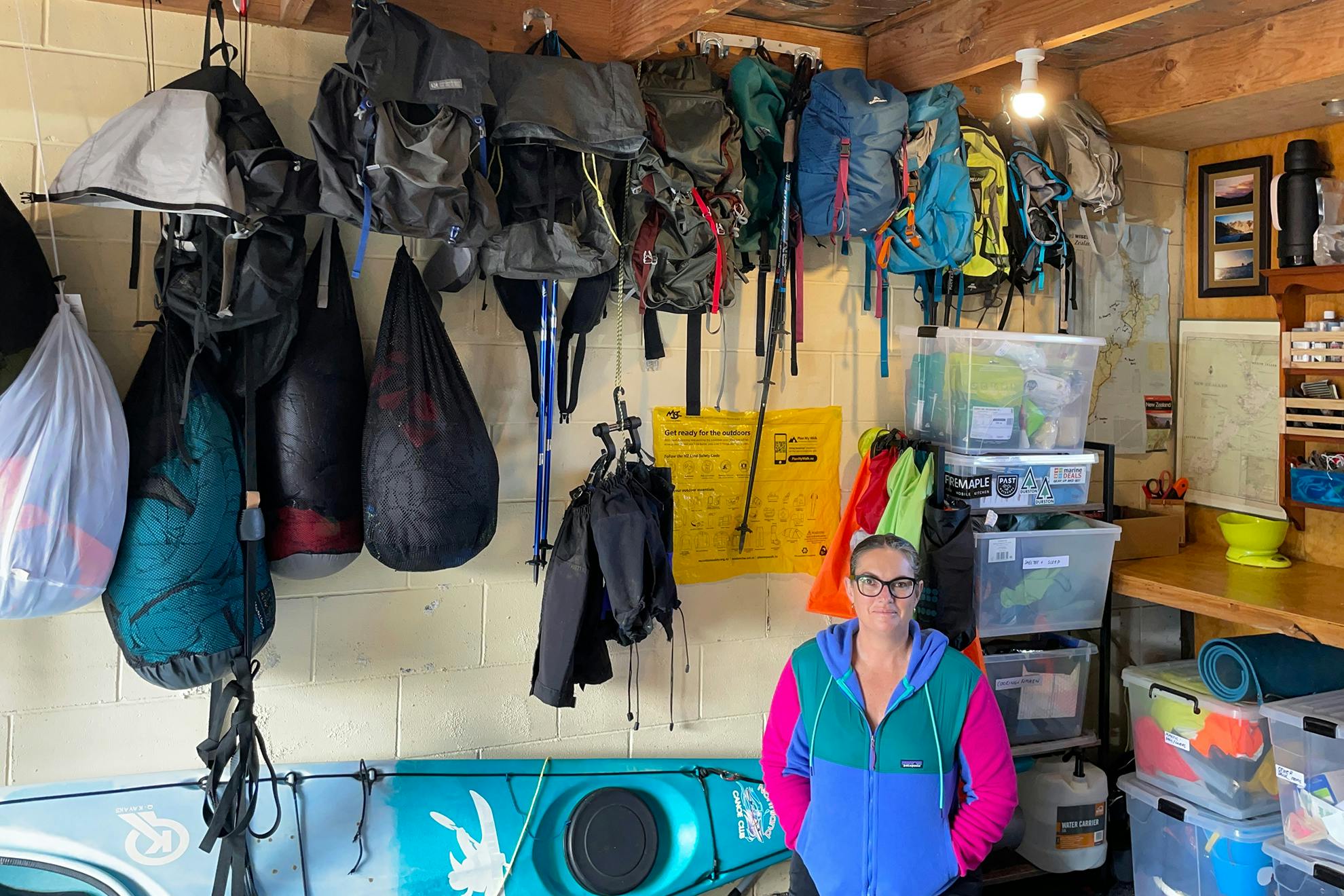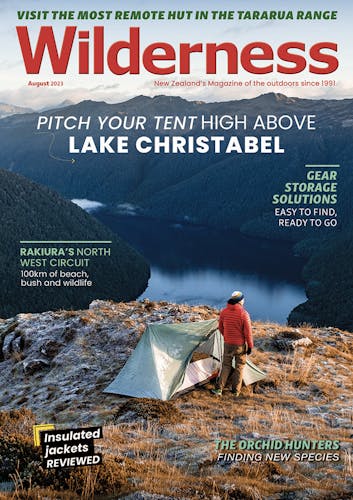How do you store your outdoor gear? Are you organised with an elaborate kit cupboard, or do you stuff it in the bottom of the wardrobe? Wilderness visited some trampers to find out how they do it.
It’s a fact: tramping needs gear, and that gear needs a home when it’s not being used, and that home depends on the space available. Keeping things neat and orderly makes it easy to find your gear so that you don’t make expensive duplicate purchases, for example. How many gas cookers do you need, after all?
Dawn, from Christchurch, has a hanging shelf for her gear: “The room has a high ceiling, so we set up a shelf and pulley system a couple of years ago,” she says. The shelf is around 2.5m long by 1.5m wide, and holds most of the things Dawn and her three children need for tramping trips. “We keep some equipment in the shed, like our camp cooker, chairs and the big family tent, but we had mice out there for a while, so we keep the everyday stuff in the house. It’s simple to access: I just lower the shelf, take everything I need, lift it up again and away we go.”
Aucklander Jénifer Silva uses the garage – almost all of it. She was an outdoor instructor 30 years ago and has recently returned to tramping with her partner and her 10-year-old son. In the last six months they’ve bought a load of new gear.
”I didn’t want to shove it in the storage area under the house, and I’m playing around with trying to get things right for everyone,” she says. “I moved everything into our garage, which has lots of space and a huge bench.”
It’s perfect, she says: “It’s all in one place, so when I pack I can see where everything is and get it together easily. If I’m stressed, I’ll go there and relax and potter. I love it.”
Plant pots got moved in favour of kit boxes, shelves, containers and pack hooks. “I spend a lot of time down there, listening to the radio while fiddling and playing with our gear to make it lighter, better and more efficient.”

Tramping food is stored there as well, and Silva sometimes does a practise run of cooking on the stove on the benchtop.
She organises things into categories but hasn’t got to the labelling stage yet, “mainly because I’m there all the time, so I know exactly where everything is.”
Elissa Albany and her partner Katie Salter knew they wanted a dedicated gear space when they built their house in Auckland: “In all the places we’ve lived before, we’ve had to put our gear into big plastic storage containers in the shed,” she says. “Every time we wanted to go hiking we had to pull out the contents of the entire shed, and packing took up all our living space.”
They’ve ended up using the guest bedroom wardrobe as a dedicated gear cupboard. “It works really well,” says Elissa. “I love being able to see everything in one go, and it makes it really easy to pack and unpack when we go tramping.”
One thing they love is being able to hang their sleeping bags up so they get plenty of air: “We found sleeping bags can get pretty gross if kept in the containers for months on end.”

There are a few things she wishes the cupboard had: “Maybe a little more space? But that’s probably always going to be the case,” she laughs. “I wish we had pro-per shelves for boots and little sections for the knick-knacks you take on a hike. And maybe proper sleeping bag hangers. It’ll come. Eventually, we’ll end up with an entire room for all our outdoor kit.”
Jo Stewart took advantage of a sauna in her house, which was built by previous owners: “I don’t have the desire to crank the room up for an occasional sauna, so it makes an excellent storage space,” she says. “It’s semi-sunken as part of the basement, with wooden shelves and walls, and it has a vent to the outside. It never gets too hot or cold, and doesn’t matter if the gear is a bit whiffy. Nothing’s gone mouldy in eight years of storage.”
Other trampers don’t necessarily have everything all in one place: Ben Wilkins has “a carefully curated and organised system of gear under the bed, in a cupboard, in the shed and in a lock-up”. Duncan McHardy has “a combination of large plastic storage bins for the bulk of gear, hanging space in the wardrobe for clothes, and a big net shelf for storing down sleeping bags”. Jo Newburry has “a spare roomful, spread haphazardly on the bed, on shelves and in my car boot – just in case”.
Tips for organising your gear
Mix it up
Different types of gear means different storage needs. Add hooks, shelves and containers of various sizes to make choosing the right type of storage easy for each item.
Hang it up
Free up precious shelf space by installing hooks for your packs. You can store gear inside them too, like other hiking packs, or kit for the next trip ready to grab and go.
Stack it up
Tarps and footprints can be folded flat (after being swept and dried) and stored on the bottom of a shelf, allowing bulkier things to be stacked on top.
Loosen up
Once you’ve dried and cleaned out your tent, store it loosely in a bag, without tension on the poles, in a cool dry place. Don’t keep sleeping bags stored in their stuff sacks; rather, stow them loosely somewhere cool and dry. Hang them up, or keep them inside a large cotton or breathable mesh sack or folded on a shelf.
Keep items neat and together
Keep all the little things in bins or drawers organised by category or type (e.g. cooking, food etc). Store similar items together, such as your sleeping gear, to make them easy to find and hard to forget when packing.
Keep it safe
Avoid accidents by storing your dangerous kit out of reach of little hands. Keep sharp items and anything toxic up high or in sealed units
Identify it
Label things clearly to save time and energy when looking for them. Maybe make a list of what’s inside a drawer or bin, or stick a photo or two on the outside.
Personalise it
Add the fun into functional by reminding yourself what items of gear are for. Add decorations such as maps, mementoes, or pictures of places you’ve been or want to go.
How and where do you store your gear? Share your ideas and we’ll post your pix in a future edition. (You’ll be rewarded with a Backcountry Cuisine meal for your efforts!) Email editor@lifestylepublishing.co.nz








